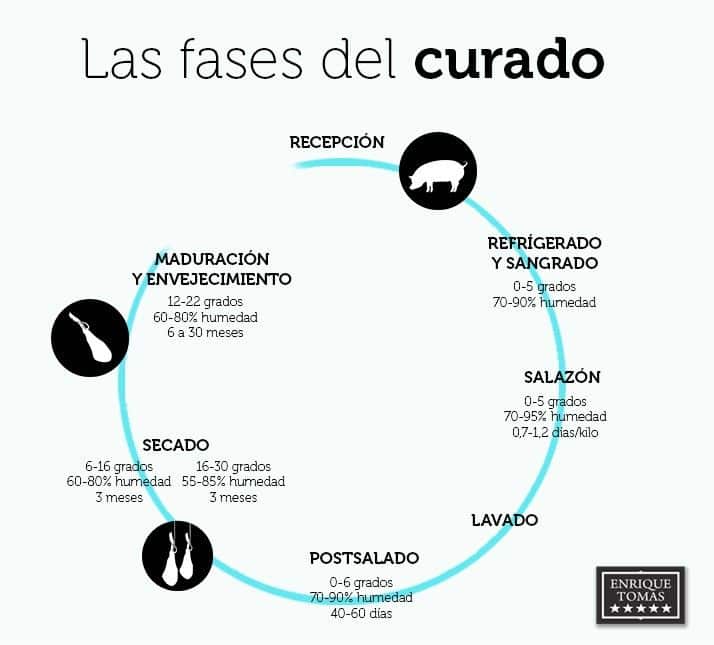
How long does it take a Jamón to be cured?
In order for a ham to be of top quality, equal attention must be given to both the care of the pig and the "cooking" of the ham, as we like to call the production stage at Enrique Tomás.
The time invested in all of this has to be sufficient to guarantee that the delicacy achieved is top-notch and not just raw meat. If you want to know how long it takes for a ham to cure, you've come to the right place. No piece is made overnight, and as evidence of this, we will explain the four phases that need to be followed and the time each one requires.
Let's get started!
Stages of Ham Curing
First Stage: Preparing the Ham
The first thing to do is prepare the leg. Once it's deboned, both the legs and shoulders go through a peeling process where they are thoroughly cleaned and rest for 24 to 48 hours to settle and temper.
After this time and before starting the "cooking" process, the pieces are massaged to remove any remaining blood. This process is carried out by specialized machines that do not affect the quality of the product.

Second Stage: Salting, Each Master Has Their Own Approach
At this point in the curing process, the hams are buried in salt to dehydrate them, enhance their flavor, and prevent the action of bacteria. Depending on the weight of the pieces and the preference of the maker, the hams will stay more or less time, although the average is usually around twelve hours per kilo. It's worth noting that while the production process of all hams is very similar, in each region of Spain and depending on the desired final product, each cook uses their wisdom and techniques to achieve different nuances, just like in wine!
Regarding the salting process, which is essentially "the action of salting a food," in the production of ham, the pieces are buried in salt. To facilitate better salt penetration, a 'V' cut is made on the top, which slightly accelerates the curing process. However, there's an exception for the shoulders from Huelva. Achieving the desired level of salting involves managing both time and the amount of salt.
The time spent in this second stage will always depend on the weight of the pieces and the maker's preference, although the average is about one day per kilo.
Third Stage: Drying, a Two-Phase Process
This stage lasts around six months and involves hanging the legs in drying rooms to allow the fat to infiltrate the muscle fibers. Initially, the pieces are hung for about three to four months in drying rooms with temperatures between 6 and 16°C and humidity of around 70%. Then, in the shorter second phase, the temperature increases to between 16 and 30°C, and the humidity percentage can vary slightly.
During this process, the skill of the "cook" comes into play as they assess the effects of each of these variables on the pieces. In this period, hams and shoulders need time and tranquility; there's no need to pay much attention to them. It's enough to monitor humidity and temperature variables and ensure they are maintained at the exact levels at all times.
Final Stage: Maturation and Aging
The duration of this stage, similar to the drying stage, depends on the quality of the meat and its weight. The pieces are hung in cellars for a period ranging from six to thirty months. Unlike the previous stage, more attention is needed at this point. To ensure that the hams are cured as evenly as possible, artisan masters apply lard to the pieces. This is especially done in areas with less fat to prevent excessive drying in those parts. When this stage is completed, the hams will be ready.
The skill of the curing masters is essential at this point, as their expertise ensures that the pieces are at their best, avoiding overly dry pieces or slices with highly variable colors. This process is entirely artisanal and is still done manually. As a curiosity, during this time, the pieces can accumulate up to 3-4 centimeters of mold, which imparts extraordinary aromas to the ham. Each region of Spain produces mold of a different color—white in Salamanca and dark in Huelva.
We've already mentioned that the duration of each stage will be longer or shorter depending on the preferences of the cooks and the weight and quality of the pieces. However, in general terms, this whole process takes 18 months for Gran Reserva hams from Enrique Tomás—the highest-quality white hams. For feed-fed Iberian hams, it takes 24 months, while acorn-fed Iberian hams take a total of 36 months to reach the perfect point for consumption.

Remember that if you want to learn more details about each of these processes and the world of ham in general, you can take a look at the book ''Jamón para Dummies''.
Once all of this is finished and all the required tests are passed to ensure that the meat is of the highest quality, it will be prepared for subsequent commercialization. By the time it reaches you, whether through our specialized stores or our website, it will be ready.
So now that you know how long it takes for a ham to cure and understand why its price is what it is, make sure to buy a top-quality one to fully enjoy all the work our artisans have put into it.



